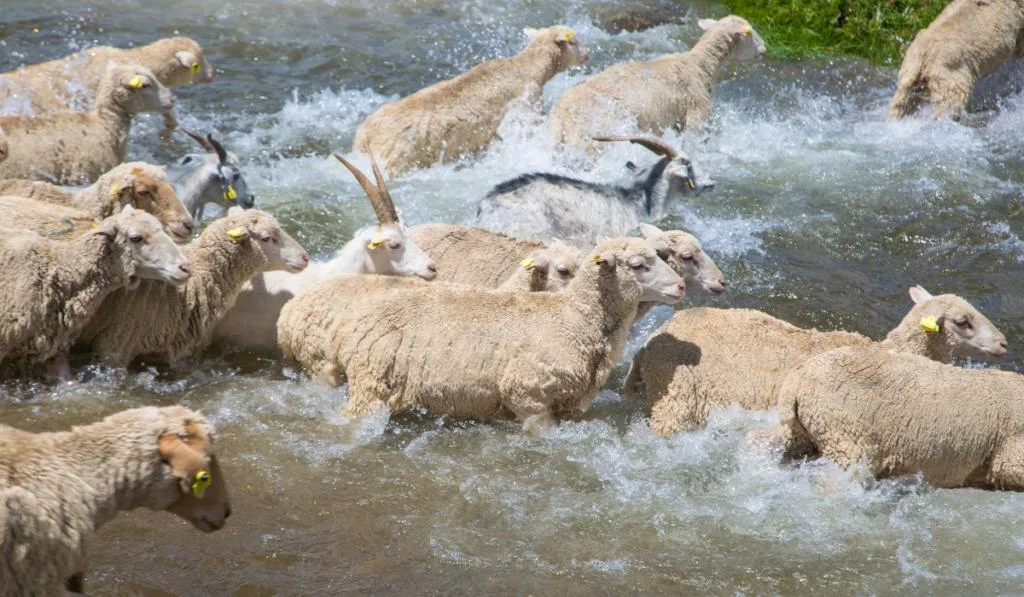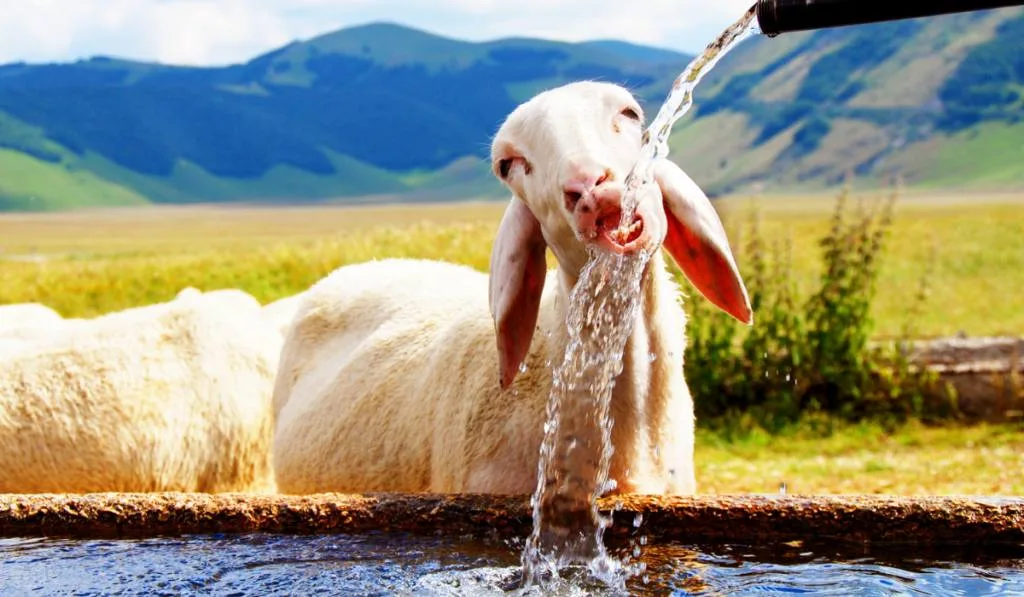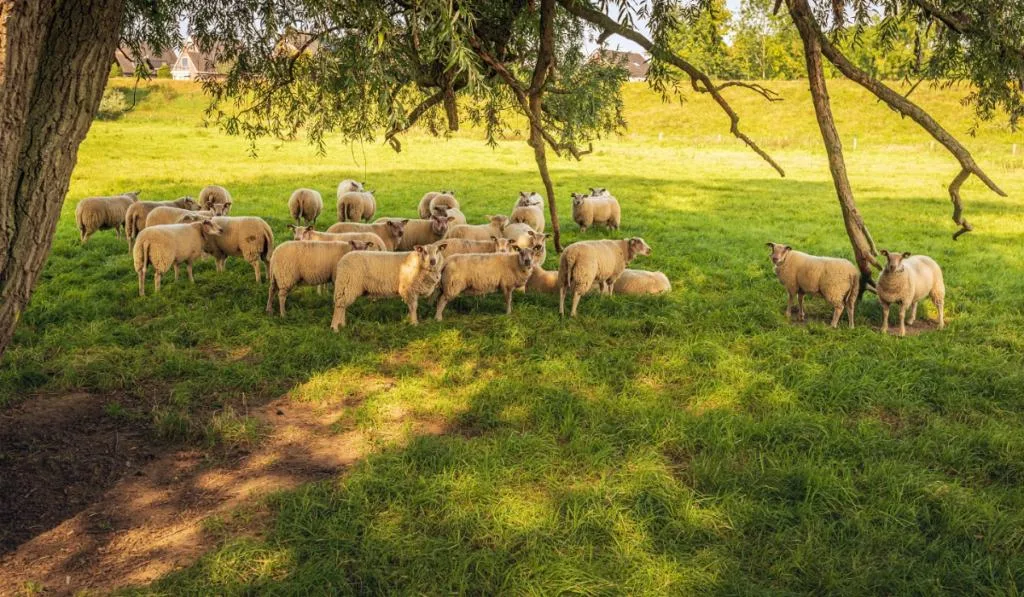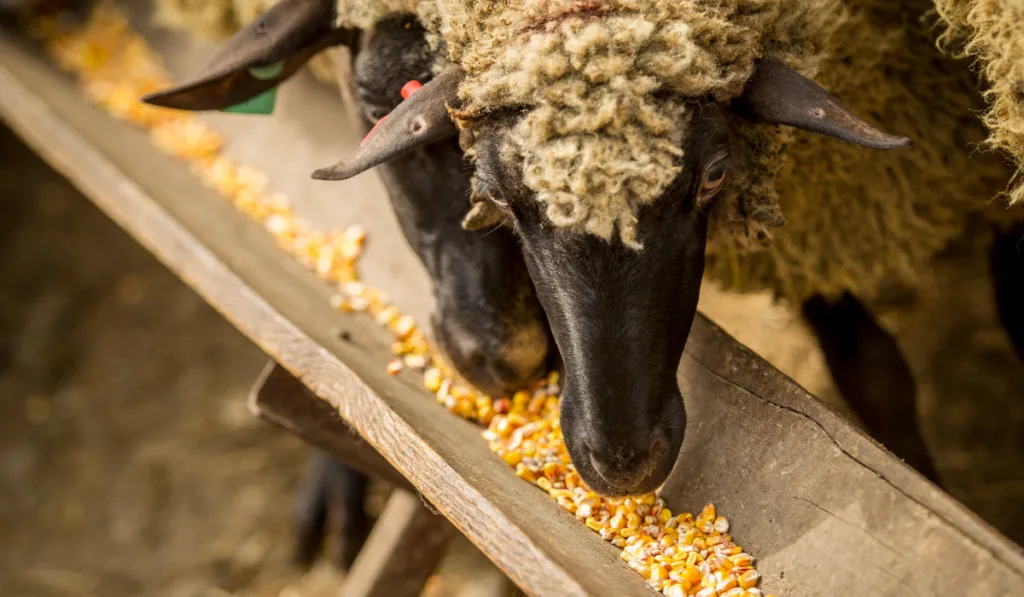Like human beings and other animals, sheep are also stressed by extremely high temperatures which affect them both directly and indirectly.
As such, managing your flock during these heat-load times calls for proactive planning.
Read on for guidelines and strategies you can follow to reduce the negative impacts of heat stress and learn how to keep sheep cool in summer.

Table of Contents
Temperature Humidity Index
Heat stress occurs when sheep are unable to sustain the balance between body heat production and body heat loss. Understanding how the temperature humidity index works will take the guesswork out of figuring out how hot is too hot for your sheep.
While the ideal temperature zone for fully fleeced sheep is 10 to 90℉ (-12 to 32oC), there is a lot that goes into determining whether your sheep will experience heat stress.
Humidity in a given region also plays a major role in determining whether sheep will experience heat stress or not.
That said, the Temperature Humidity Index (THI) is the most reliable way to tell if your flock is at risk of heat stress. In this case, you can expect heat stress to occur in your flock when your region’s THI is at:
- A moderate of 82 to anything less than 84°F (29oC)
- Severe levels of 84 to anything less than 86°F (30oC)
- Extreme levels of anything equal to or greater than 86°F (30oC)
While the Temperature Humidity Index is the primary measure of heat stress, other factors that influence heat stress on your sheep include:
| Factors | Influence on Heat Stress |
| Breed | Breeds with shorter legs, necks, smaller ears, and compact bodies originating from cooler regions are more prone to heat stress. |
| Pregnancy | An increase in heat production during gestation predisposes sheep to heat stress. |
| Fleece | Shorter wool allows radiant energy to pass through the skin increasing the risk of heat stress. |
| Age | Lambs are at higher risk of heat stress due to their short fleece length, higher respiration rate, and high metabolic heat production. |
| Wind speed | Heat stress risk increases with low wind speed or calm air conditions. That is, zero wind velocity reduces convective heat loss. |
| Solar radiation | Solar radiation heat can exceed the metabolic heat in sheep. |
| High night-time temperatures | This prevents the loss of heat gained during the day and therefore increases the risk of heat stress. |
Heat Stress Indicators in Sheep
As with other livestock, there are visual signs you can use to tell whether your flock is already experiencing the heat stress associated with extreme summer temperatures. Some of these indicators will even inform you of the heat stress level your flock is experiencing.
- Continuous panting
- Elevated rectal temperature
- Huddling together
- Increased respiration rate which might be accompanied by deep chest movements
- General weakness
- Restlessness
- Immobility and or staggering
- High water intake

When it comes to continuous panting, flock owners should look out for this behavior to determine the next course of action:
- Mild heat stress: mild to fast closed-mouth panting accompanied by visible chest movements.
- Moderate heat stress: fast panting with mouth slightly opened but the tongue is not past the lips yet. This is also accompanied by visible and rapid chest movements.
- Severe heat stress: fast open mouth panting with an extended neck. At this point, the head will be held up and the tongue extended.
- Extreme heat stress: open mouth panting with a fully extended tongue and lowered head. Panting periods will alternate with deeper breaths.
With these in mind, here are surefire tips to keep sheep cool in summer. Some of these heat stress mitigation tips can be conducted in advance while others can be conducted even when your flock is already heat stressed.

4 Tips to Keep Sheep Cool in Summer
1. Increase the Water Supply
Keeping your flock hydrated should be your first concern when it comes to keeping sheep cool in summer.
As expected, water consumption by your flock will drastically increase during summer in general and even more so when trying to fight heat stress.
This is especially so in lambs than adult rams and ewes due to their high metabolic rate and short wool length. Constantly check on your automatic drinkers to ensure a steady flow of clean and fresh water that is clear of debris.
Even with automatic drinkers, adding several buckets of fresh clean water in your barns will ensure that there is enough water for every sheep. Similarly, you can add electrolytes packed with amino acids and energy to help your flock replenish lost nutrients and fluids.
2. Consider Shearing in the Spring Months
As tempting as shearing might be when trying to keep sheep cool in summer, it should be avoided completely in the summer months.
This is because even a small layer of fleece has insulating properties that help sheep regulate their internal temperature.
Safe shearing should be left for spring when it is warm enough for your flock to survive without wool. This also offers an opportunity for it to grow back in summer and hopefully grow to a full coat by winter when they need it to stay warm.

3. Provide Ample Shade and Ventilation
Like people, your flock will also seek shade and shelter from the sun when trying to avoid heat stress.
Luckily, there are numerous options for a shade that you can never go wrong with. For instance, large trees, haystacks, and bushes are great natural shade options.
On the other hand, you can opt for a mesh shade cloth or tarp. As you can see, it comes down to how you want to do it based on your flock’s needs. The most important thing is to offer shade for the whole flock.
Similarly, you can opt for movable shade structures that are ideal for practicing rotational grazing in summer. Besides improving the animals’ welfare, availing shade to your flock could also lead to improved milk production, reproduction, and weight gain.
If your flock is housed in a permanent structure, your focus should be on availing ample ventilation. You can do this naturally or with the help of fans to expel warm and moist air and replace it with fresh cool air.
4. Offer a Nutrient-Dense Diet

Even without the stress of heat stress or stroke, the quality of pasture tends to be poorer during the hot summer weather. For this reason, having a high-quality grain blend is a perfect way to supplement the unavailability of good pasture.
Keep in mind that heat-stressed ewes tend to have a reduced milk supply and should be supplemented with milk replacers if your lambs are not yet weaned.
Final Thoughts
As you can see, proactive planning is crucial when it comes to learning how to keep sheep cool in summer.
More often than not, a severe heat stress situation can turn into an extreme one within seconds, which can lead to major losses in your production if not properly anticipated.
But with this information, you are better prepared to make the right decisions and take the necessary measures to keep your flock safe and healthy.
Resources
- https://agriculture.vic.gov.au/support-and-resources/newsletters/sheep-notes-newsletter/sheep-notes-autumn-2020/signs-and-management-of-heat-stress-in-sheep
- https://u.osu.edu/sheep/2022/05/24/heat-stress-in-small-ruminants-2/
- https://www.sheepandgoat.com/heatstress
- https://www.morningagclips.com/help-your-lambs-beat-the-heat/
- https://www.lamlac.co.uk/latest/view,the-heat-is-on-managing-sheep-in-a-heatwave_123.htm
- https://www.farmprogress.com/animal-health/4-steps-to-help-lambs-beat-the-summer-heat
- https://www.brimwoodfarm.com/articles/how-to-keep-sheep-cool-in-summer
